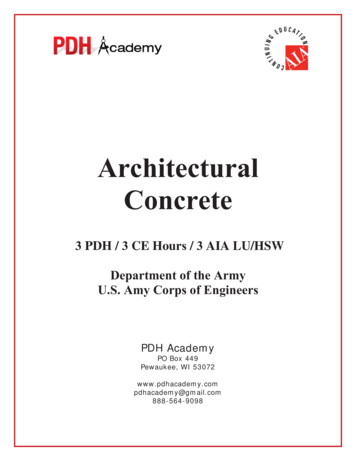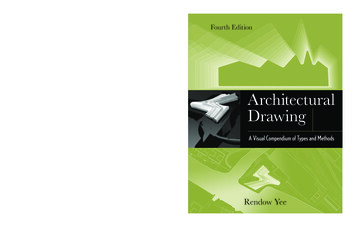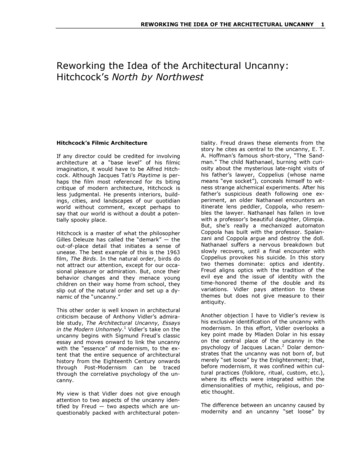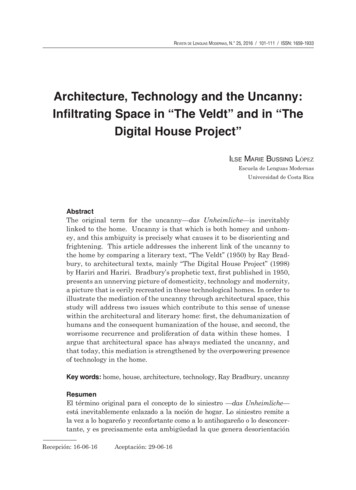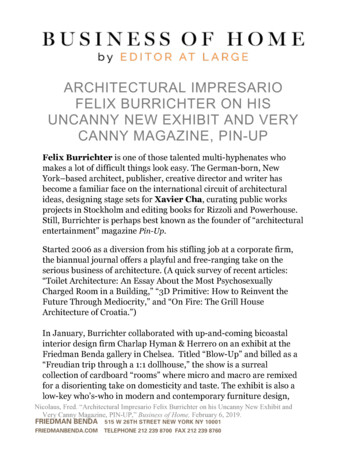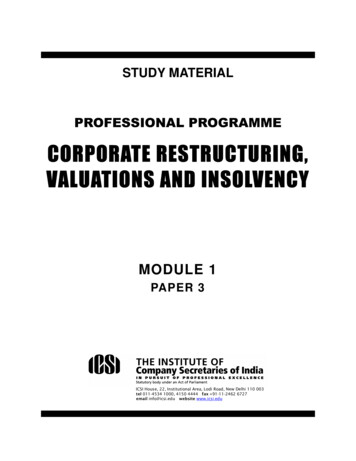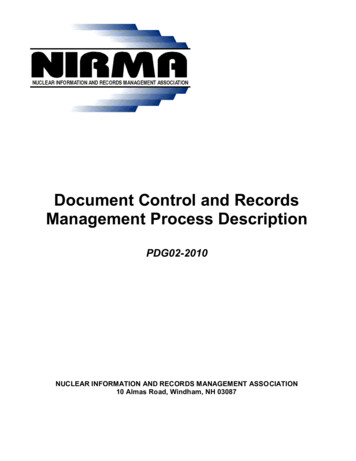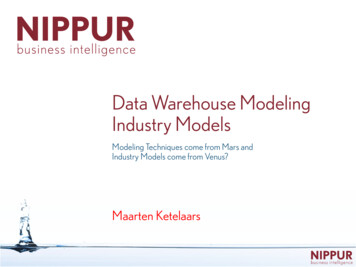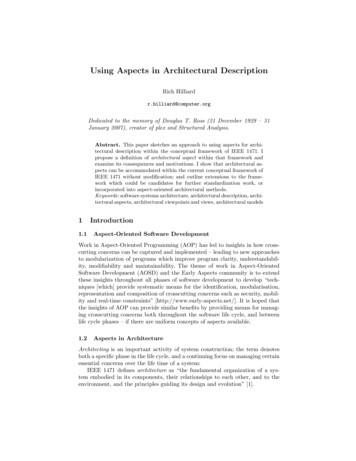
Transcription
Using Aspects in Architectural DescriptionRich Hilliardr.hilliard@computer.orgDedicated to the memory of Douglas T. Ross (21 December 1929 – 31January 2007), creator of plex and Structured Analysis.Abstract. This paper sketches an approach to using aspects for architectural description within the conceptual framework of IEEE 1471. Ipropose a definition of architectural aspect within that framework andexamine its consequences and motivations. I show that architectural aspects can be accommodated within the current conceptual framework ofIEEE 1471 without modification; and outline extensions to the framework which could be candidates for further standardization work, orincorporated into aspect-oriented architectural methods.Keywords: software systems architecture, architectural description, architectural aspects, architectural viewpoints and views, architectural models11.1IntroductionAspect-Oriented Software DevelopmentWork in Aspect-Oriented Programming (AOP) has led to insights in how crosscutting concerns can be captured and implemented – leading to new approachesto modularization of programs which improve program clarity, understandability, modifiability and maintainability. The theme of work in Aspect-OrientedSoftware Development (AOSD) and the Early Aspects community is to extendthese insights throughout all phases of software development to develop “techniques [which] provide systematic means for the identification, modularisation,representation and composition of crosscutting concerns such as security, mobility and real-time constraints” [http://www.early-aspects.net/]. It is hoped thatthe insights of AOP can provide similar benefits by providing means for managing crosscutting concerns both throughout the software life cycle, and betweenlife cycle phases – if there are uniform concepts of aspects available.1.2Aspects in ArchitectureArchitecting is an important activity of system construction; the term denotesboth a specific phase in the life cycle, and a continuing focus on managing certainessential concerns over the life time of a system:IEEE 1471 defines architecture as “the fundamental organization of a system embodied in its components, their relationships to each other, and to theenvironment, and the principles guiding its design and evolution” [1].
Software systems architects routinely practice separation of concerns andmust deal with crosscutting concerns because a primary job of the architect isto insure the quality of a system. While functionality is relatively easy to identify, specify and localize, other qualities (frequently lumped together as simply“non-functional concerns”) are pervasive, prevailing architectural concerns. Theessence of the architect’s job is to negotiate and balance these conflicting concerns of many diverse stakeholders to construct a feasible, functioning system.The characterization in the previous paragraph is analogous to the situationin programming which motivated the invention of aspects. Perhaps the force ofcrosscutting concerns is even stronger at the architectural level than in implementation – at least if we take “Boehm’s Law” seriously. Qualities dominatethe architect’s job, whereas functionality is often a consideration which can bedeferred to subsequent design and implementation.Further, this is equally true in systems architecture as in software architecture; so it would be useful to have solutions which are applicable in eitherdomain, since both are frequently parts of major system developments [2].Therefore, it is worth asking whether there is a role for aspects, or aspect-likeconstructs, within Architecting. This is a big question and not a new question; ithas been raised already in the Early Aspects community. This paper will focuson one topic within the larger question:How can aspects be used within Architectural Description?This focus is justified by observing that aspects are largely an approach tomodularization, and therefore a syntactic notion. So answers to this questionshould be offered within the context of existing representational resources. Notethat the representational resources for architectural description are quite different from those used in design and implementation. In AOP, aspects crosscut program texts, whereas in modern architectural practices, architectural descriptionsare organized using multiple views – can we make sense of aspects crosscuttingarchitectural views? What problems and opportunities does this present?1.3Outline for the remainder of paperIn the next section, I outline the conceptual framework for architectural description which forms the basis for IEEE 1471. I go into some detail, because itsdetails make possible the introduction of aspects without modification to theframework. In section 3, I apply the conceptual framework to derive a workingdefinition of architectural aspect and then suggest extensions to the frameworkwhich clarify some matters and may be useful for developing aspect-orientedarchitectural methods. In section 4, I survey related work: the question of therole of aspects in Architecting has been raised by others. I contrast the currentapproach with other work. The final section contains some conclusions.
22.1A Conceptual Framework for Architectural DescriptionIEEE 1471IEEE Std 1471, Recommended Practice for Architectural Description of SoftwareIntensive Systems [1] was the first formal standard to address what is an architectural description (AD). It was developed by the IEEE Architecture WorkingGroup between 1995 and 2000 with representation from industry, other standards bodies and academia, and was subject to intensive reviews by over 150international reviewers, prior to its publication in 2000.In 2006, IEEE 1471 became an draft international standard (ISO/IEC DIS42010) and is now undergoing joint revision by IEEE and ISO (http://www.isoarchitecture.org/ieee-1471/). One of the motivations for this paper is to examinewhat changes are needed in IEEE 1471 to support aspect-oriented architecting.IEEE 1471 establishes a set of content requirements on an architectural description (any collection of products used to document an architecture) on howADs should be organized and their information content, while: (i) abstractingaway from specific media (e.g., text, HTML, XML); (ii) being method-neutral (itis being used with a variety of existing and new architectural methods and techniques); and (iii) being notation-independent (recognizing that diverse notationsare needed for recording various facets of architectures).IEEE 1471 is built upon a conceptual framework for architectural description(see Figure 1).The content requirements of an AD per IEEE 1471 are stated using the termsand concepts of the conceptual framework. These rules define what it means foran architectural description (AD) to conform to the Standard. The key conceptsneeded for discussing architectural aspects are summarized in the remainder ofthis section.2.2Architectures and Architectural DescriptionsI have cited IEEE 1471’s definition of “architecture” in the Introduction, and itsfocus on architectural descriptions (ADs): work products used to document thearchitecture of a software-intensive system.Although perhaps obvious to some, the conceptual framework distinguishesarchitectures from architectural descriptions. Architectures are conceptual entities. Architectural descriptions are concrete artifacts.Architects do their best to express their concepts in a concrete representationwhich can be captured, managed, reasoned about and shared with others. Theforce of the standard is on ADs – that which can be concretely captured. Beingclear about conceptual entities (architectures) versus artifacts (ADs) will beuseful when concerns and aspects are discussed below.2.3Stakeholders and ConcernsThe audiences for an AD are the various stakeholders of the system.
Fig. 1. IEEE 1471 Conceptual Framework
A stakeholder is any person, organization or other entity with an interest inthe architecture of the system.The recognition of the role of stakeholders in the AD reflects the multidimensional, multi-disciplinary nature of Architecting [4] and facilitates the architectural understanding of their interests with respect to the system.Within IEEE 1471, those interests are called architectural concerns (or concerns for short).Concerns are those stakeholder interests pertaining to the system’s development, design, operation, or any other area, which are critical to its architecture.Each concern is an issue which the architecture, and therefore the architecturaldescription, must address. Familiar concerns include: functionality, security, performance, constructibility, reliability – all of which are often considered to beassociated with early aspects.Concerns arise at all stages of a system’s construction and operation – it oftentakes an Architect to recognize which concerns are architecturally significant andcannot be deferred. IEEE 1471 says nothing about the granularity of a concern:it may be as broad as data distribution or as specific as operator security policy.The sum total of these concerns presents the Architect with a set of problemsto solve; the Architect’s job is to describe a system manifesting properties thatwill allow the needs and concerns of the stakeholders for the system to be met.Therefore, an AD should be explicit in addressing these stakeholders. Underthe rules of IEEE 1471, an architectural description must explicitly identifythe stakeholders of the system’s architecture and enumerate each architecturalconcern. If an AD does not address all identified stakeholders’ concerns it is, bydefinition, incomplete.2.4Architectural Viewpoints and ViewsWhat the Viewer brings to the Viewed in the Viewing, yields the View.– Douglas T. RossIt is routine among architectural methods and frameworks to use multiplearchitectural views as a fundamental organizing principle of architectural descriptions to capture information about an architecture (e.g., [5,6,7,8,9,10,11]).In IEEE 1471, an AD is organized into one or more architectural views. Anarchitectural view is defined to be “a representation of a whole system from theperspective of a related set of concerns”.There are many reasons for introducing views, pertaining to separation ofconcerns and management of complexity (for discussion see [12]). However, earlywork on architectural views was relatively informal with respect to what constituted a view and how its contents were to be created and analyzed.Although the use of multiple views was hardly new in IEEE 1471, its contribution is three-fold:(i) to provide conventions for rigorously defining, and therefore using,the contents of a view;
(ii) to motivate the selection of views for use through their ability toaddress specific concerns of specific stakeholders; and(iii) to articulate a “wholeness condition” on views that contributesto the relevance, well-formedness, consistency and completeness of ADs.In IEEE 1471, the permissible contents of an architectural view is governedby specifying an architectural viewpoint.The idea of a viewpoint first appeared in Ross’ Structured Analysis (SADT)[13]. Nuseibeh, Kramer and Finkelstein, working in requirements engineering,treat viewpoints as first-class entities, with associated attributes and operations[14]. The ISO/IEC Reference Model for Open Distributed Processing (RM-ODP)defines “viewpoint (on a system): a form of abstraction achieved using a selectedset of architectural concepts and structuring rules, in order to focus on particularconcerns within a system” [15].All of these precedents contributed to the IEEE 1471 notion:an architectural viewpoint is “a specification of the conventions for constructing and using a view. A pattern or template from which to developindividual views by establishing the purposes and audience for a viewand the techniques for its creation and analysis”.Each architectural viewpoint used in an AD must be “declared” before use(either “in line” in the AD or by reference to its source). Table 1 is a templatefor specifying a viewpoint in accordance with IEEE 1471.Table 1. Ingredients of a Viewpoint (based on IEEE 1471)A viewpoint is defined by:– the viewpoint name;– a set of architectural concerns to be framed by the viewpoint. Views conforming tothat viewpoint must address each of those concerns;– a set of representational resources to be used in constructing conforming views, suchas viewpoint languages, modeling techniques and analytical methods; and,– the source, if any, of the viewpoint (e.g., author, literature citation) if it is defined byreference.A viewpoint definition may additionally include:– any formal or informal consistency or completeness checks associated with the underlying method to be applied to models within the view;– any evaluation or analysis techniques to be applied to models within the view; and– any heuristics, patterns, or other guidelines which aid in the synthesis of an associatedview or its models.
Each architectural view has a governing architectural viewpoint. The viewpoint provides the set of conventions for constructing, interpreting and analyzinga view, including the rules for determining whether it is well-formed.Each identified stakeholder concern must be framed by at least one of thearchitectural viewpoints selected for use in an AD; if not, the AD is incomplete.Making viewpoints first-class provides a means by which the variety of architectural techniques in use today can be uniformly described and thereforecompared and perhaps made interoperable.2.5Architectural ModelsIn IEEE 1471, “a view may consist of one or more architectural models”. Verylittle else is said about the use of such models in the 2000 edition of the standard,which has led to some confusion.There were two motivations for introducing models into architectural views.First, in order to address a related set of concerns, some views might need toemploy more than one type of notation. Per the rules on viewpoint specifications(Figure 1), when a view requires more than one notation, this is captured withinthe viewpoint definition, specifying the multiple models to be used and thenotations for each.For example, Kruchten’s 4 1 Logical viewpoint uses both UML class diagrams and UML component diagrams. These would each be determined in theassociated viewpoint definition. Another example could be a Project Management viewpoint specifying that project management views include three typesof model: GANTT charts, budgets and org charts to fully address project management concerns.A second use of architectural models is to capture in one place some architectural detail that contributes to addressing distinct concerns in more than oneview – without requiring explicit repetition of that detail in each view.IEEE 1471 does not provide any further rules or guidance on the use ofarchitectural models within views; this was left open to users of the Standard.Clearly this latter usage of architectural models is close to the intended purpose of aspects. Architectural models are the essential element of the frameworkfor supporting architectural aspects, as discussed in the next section.3Architectural AspectsThe previous section presented a somewhat detailed description of the IEEE 1471conceptual framework. In this section, I propose a definition of architectural aspect and examine its implications within the IEEE 1471 conceptual framework,demonstrating that aspects can be directly accommodated therein. I then suggestsome extensions to the conceptual framework which make its support for architectural aspects clearer, and which are independently motivated for improvingthat framework. I refer to existing concepts of AOP (including join points, point
cuts, advice, base and aspect languages, symmetric and asymmetric paradigms)to motivate the presentation.Let’s begin with a definition. In the remainder of this section, I will examineits consequences and motivations, using the “AOP metaphor” to explore theapplicability of aspects to Architectural Description.Definition. An architectural aspect is a shared architectural model addressingexactly one architectural concern.Model sharing is the architectural analog of the primary motivation for aspects in AOP: to modularize a representation addressing concerns that wouldotherwise be scattered, and repeated, across multiple views. Sharing is thuscrucial in the definition to capturing the crosscutting nature of aspects.1 If anarchitectural model is not shared, then by the definition here, it is not an architectural aspect – it is merely a constituent of a view.One immediate consequence of this definition is that it explains what entities architectural aspects crosscut: they crosscut views and the models whichcomprise those views.A second consequence, following from the definitions and rules described insection 2, is that it classifies architectural aspects into:1. intra-view aspects (aspects which apply within a single view); and2. cross-view aspects (aspects which apply across two or more views).More about these two classes below.Finally, defining architectural aspects to be essentially a specialization of theexisting construct of architectural model is consistent with other practices inAOSD (such as aspect-oriented design) and requires nothing new be added tothe IEEE 1471 conceptual framework to support architectural aspects.Architectural Concerns. Architectural concerns in IEEE 1471 appear tomatch the idea of concern in AOSD, although not necessarily used in a rigorous manner within that community. (There has been some recent work onconcern-based modeling, see 4.)A concern is a statement of an area of interest on the part of a stakeholder inthe architecture of the system. A concern frames a problem to be solved by thearchitecture. A concern may be large or small, wide or narrow, requirements-,design- or constraint-oriented . the essence is that it reflects a statement. The1At least within “asymmetric” approaches to aspects, which I will tentatively assumehere, although it remains an open question. Under the asymmetric approach, aspectsare added to the base – the set of views of the system. For practical reasons, I thinkArchitectural Description will remain view-based because views are frequently organized for an architecture’s diverse stakeholders. Adopting the symmetric paradigmwould be a radical change for Architectural Description, and would blur the organization of information for stakeholders. This is different from the situation in AOPwhere, in a sense, there is a single stakeholder: the programmer.
rigor arises as follows. Architectural concerns must be recorded and accountedfor in the AD. Each identified architectural concern must be recorded such thatan AD is incomplete if there are any concerns which have not been framed by atleast one viewpoint.There are concerns of varying granularities: a major concern may warranta viewpoint of its own (e.g., Functionality, or Distribution). A minor concernmight not require its own viewpoint, but could be grouped with others withina viewpoint (e.g., Extensibility of system functionality might be grouped withFunctionality).By limiting an aspect to a single concern in the definition, an aspect becomes the most fine-grained solution element expressible within the framework– without referring to elements of a particular viewpoint language.It is worth noting that architectural aspects as defined above are quite distinct from aspects that might arise within aspectual (aspect-oriented) viewpointlanguages. These are two distinct levels of description. There is no simple relationship between architectural aspects and aspectual languages used as viewpoint languages. Architectural aspects crosscut models and views; whereas aspectual languages within viewpoints would not introduce any crosscutting at anarchitectural level.Insights from AOP. Key notions of AOP are join points, point cuts andadvice; defined in relation to base and aspect languages. In this section, I brieflydiscuss the relevance of these notions within Architectural Description, leadingup to a proposal at the end of this section.Unlike the situation in AOP, in Architectural Description there is no singlebase language; since architectural aspects crosscut views, each viewpoint language is a potential base language.2 Similarly, an architectural aspect could bewritten in any other viewpoint language chosen to address the identified concern.All languages used in an AD are, by definition, viewpoint languages and must bedefined by some viewpoint. Given this, what can we say about base and aspectlanguages in an architectural setting?Consider Figure 2, which depicts examples of the two kinds of architecturalaspects: intra-view and cross-view aspects. For intra-view aspects, the viewpointestablishes the language to be used for each model. Typically, an intra-viewaspect will use the same viewpoint language as the rest of the viewpoint becausethe concern addressed by the aspect may be subsumed by the concerns framed bythe viewpoint – but not necessarily. The aspect may be encapsulating everythingthere is to say about its identified concern utilizing a language not used elsewhere,but it is still part of a single viewpoint.For cross-view aspects, the issue of where the aspect language should bedefined is not currently addressed by the Standard. There was a notion inIEEE 1471 that each model was: (i) defined by exactly one viewpoint: Viewpoint establishes methods for one or more Models) and (ii) possibly used in other2We could say aspect-oriented architectural description does not enjoy the Luxury ofthe Monolinguistic Base – the flip side of the Tyranny of Dominant Decomposition.
Fig. 2. Examples of intra-view and cross-view architectural aspectsviews: Model participates in one or more Views); but this was reflected only inthe diagram (Figure 1) – there were no rules based on this notion nor any furtherelaboration. This is an area for improvement in the on-going IEEE 1471 revision.A join point is a location expressed in a base language at which an aspect isto be applied. These will be elements of viewpoint languages.A point cut is an expression which picks out a set of join points based on somecriteria. Such expressions will be part of the specification of an architecturalaspect, and will determine where it applies. This may involve quantificationof some kind [16]. Advice refers to the rules for combining aspects with baseelements to yield the final result.An architectural aspect can be similarly characterized by its interface (pointcut expression) and its body (advice), as proposed below.Improving Architectural Models. Addressing the considerations of the previous section (analogues of join points, point cuts, advice) for architectural aspects necessarily involves architectural models, since by definition, aspects area specialization of models. In fact, it can be argued that mechanisms for theseare useful independent of aspects. This section will briefly make such a proposaland offer an example.Currently, these considerations fall under the slogan of view (or model) integration. In IEEE 1471, there are no rules pertaining to this; it is an obligationon the end user to specify integration rules as a part of viewpoint definitions.However, with an increased emphasis of models, it might be possible to do better in the revision of the standard, or as a part of aspect-oriented architectural
description methods. In particular, there should be a clear solution for modelsshared across views. Ideally, aspect weaving or composition would be a specialcase of model integration, but this is an area for future work.One approach is to revive the provides and requires language of module interconnection to state relations between views and models. In Figure 3, a cross-viewaspect, Fault Handling, is depicted. In the UML cartoon, (and in the previousfigure), views, models and aspects are denoted by UML packages, with an appropriate stereotype ( view , model and aspect , respectively). Arrowsshow dependencies; such as the application of an aspect to a view. A requiresclause captures the element types from a viewpoint language to which an aspectapplies (join points). The provides clause captures the element types “delivered”by the aspect. Taken together, the provides and requires clauses establish a contract between models. This is generally useful; not just for specifying aspects forany architectural models and views [17].Fig. 3. Example: Fault Handling
Another approach could be to introduce a generalized notion of architecturalelement, as a entity within a view associated with a sort or type defined by itsviewpoint, over which to allow quantification.Under either approach, I suspect universal quantification over types is sufficient for most architectural applications.View integration in general, the nature of quantification needed, and theinvestigation of these alternatives, are topics for future work.Consider3 ::: view : viewpointmodel :A viewpoint defines the rules on a view; where are model rules defined? InIEEE 1471 currently, model rules are part of the viewpoint definition (as perFigure 2), but, as noted above, that does not really address the case where amodel (whether or not it is an aspect) is shared by two or more views (such asthe cross-view aspects introduced above).should beMark Gerhardt has suggested that for the IEEE 1471 revisionfilled by an architectural model type (or metamodel). A model type would identifythe concerns addressed by its model (instances), the model language to be used,and any additional conventions. Viewpoint definitions could then reference thesemodel types. The provides/requires contracts would contribute to defining modeltypes.4Related WorkThere are three major themes of “related” work – in addition to a few otherapproaches – which may be classified as follows:– aspects within a components and connectors-based viewpoint;– concern-oriented approaches; and– crosscutting architectural constructs.Each elucidates some of the issues raised in this paper. I discuss each of thesethemes in turn.Aspects in Component-based Viewpoints. A body of work presumes abase representation of components and their connectors, as found in many architecture description languages (ADLs). These include AspectualACME [18],TranSAT [19], Fractal Aspect Component, CAM/DAOP [20], and FuseJ [21]. Inthese languages, aspects crosscut components and connectors which are elementsof the viewpoint language, and the aspects themselves are viewpoint language(ADL) elements. This is in contrast to the present work in which aspects crosscut views. These might better be referred to as component or connector aspects,rather than architectural aspects.3This notation is useful for expressing analogies: a : b :: c : d which is to be read “ais to b as c is to d”.
Concern-oriented Approaches. The introduction of architectural concernsinto IEEE 1471 arose from attention to separation of concerns in software engineering. Recently, concerns have become of increasing interest in their own rightwithin the Aspects community and elsewhere [22,23]. Sutton and Tarr rightlynote that concerns are concepts not artifacts; IEEE 1471 focuses on makingexplicit identified concerns; those which have been captured and recorded:“If we consider a concern to be any matter of interest in a software system, then concerns subsume aspects as they are usually defined. Thecommonly accepted definition of aspect (in this context) is a programproperty that forces crosscutting in the implementation []. This definition recognizes the distinction between concerns (specifically properties)and artifacts (specifically implementations), and it calls attention to animportant implementation issue. However, it is relatively narrow (focusing on properties and implementations), it categorizes concerns by theireffects (rather than by more intrinsic characteristics), and it links theidentification of those concerns to artifacts. In our view, a general notion of concern is needed for AOD (and AOSD in general), one that isnot dependent on or linked to notions of artifact.” [23]Approaches to concern modeling could be used within the IEEE 1471 framework,and could lead to additional future requirements in this area for the revision.Although starting from a different foundation than this paper, Katara andKatz develop several mechanisms which could be of use in the present context[24]. Their work could be used to extend the suggestions here for interpretingjoin points using the language of provides and requires for view integration.Other Crosscutting Architectural Constructs. There are other crosscutting constructs proposed for architectural description that have uses similar toaspects. Two such constructs are architectural perspectives and textures.Rozanski and Woods (R&W) define perspectives this way [8]: “An architectural perspective is a collection of activities, tactics, and guidelines that are usedto ensure that a system exhibits a particular set of related quality propertiesthat require consideration across a number of the system’s architectural views.”Typically, R&W note, “Applying a perspective almost always leads to thecreation of something – usually some sort of model – that provides an insightinto the system’s ability to meet a required quality property.”A perspective is so close to a viewpoint, which R&W are already using, it isnot clear why they needed to introduce it. Like a viewpoint, a perspective definesa set of resources to be used to address a particular set of quality properties (i.e.,concerns). Many of their perspectives (Security, Performance and Scalability,Evolution) would just as easily be defined as viewpoints, and R&W’s templatefor perspectives is equivalent to the IEEE 1471 template for viewpoints (althoughmore refined).Alexander Ran and colleagues have described architectural textures as
incorporated into aspect-oriented architectural methods. Keywords: software systems architecture, architectural description, archi-tectural aspects, architectural viewpoints and views, architectural models 1 Introduction 1.1 Aspect-Oriented Software Development Work in Aspect-Oriented
